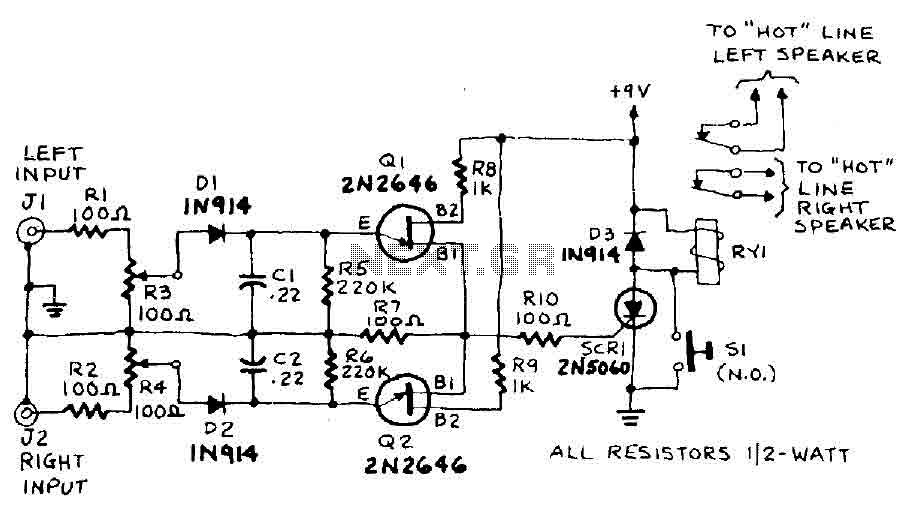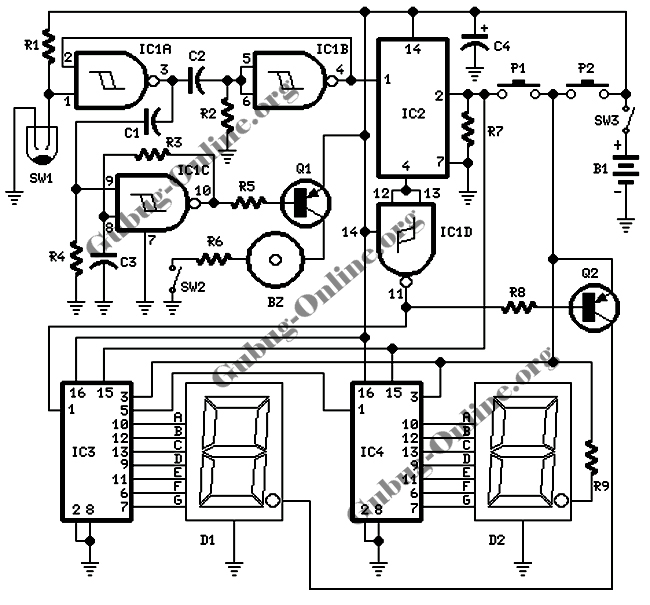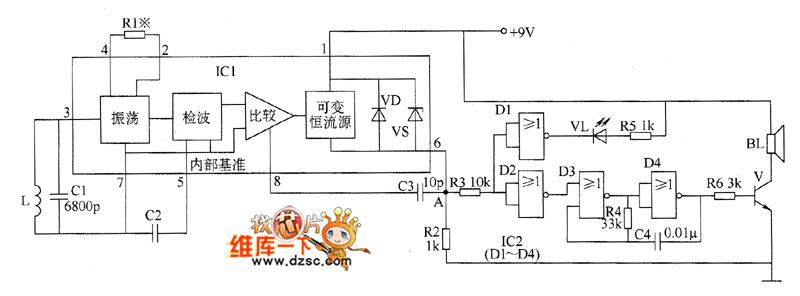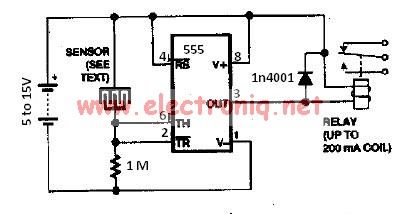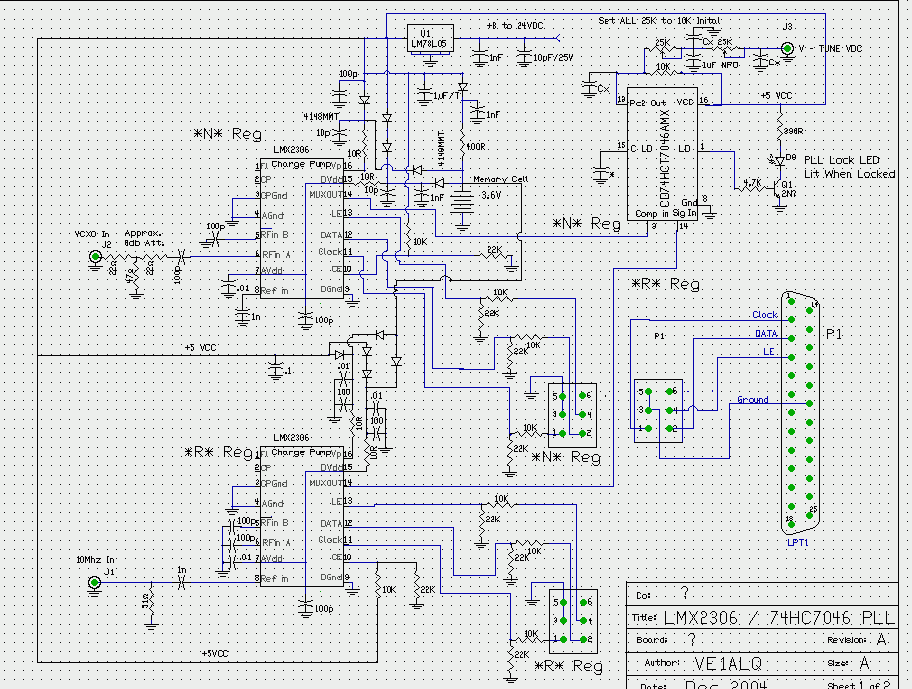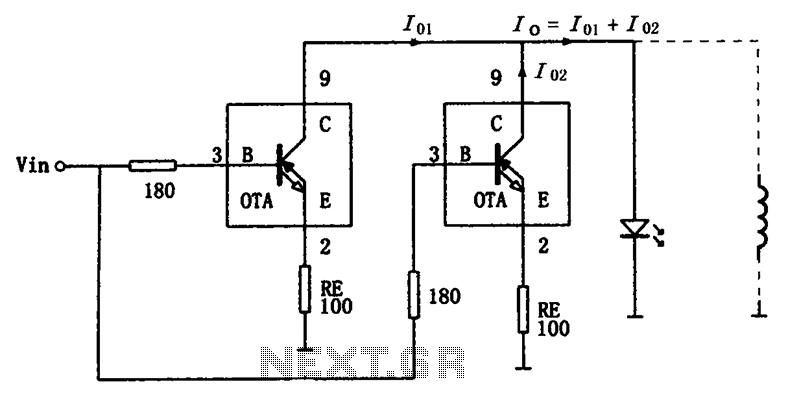
Lighting controller circuit
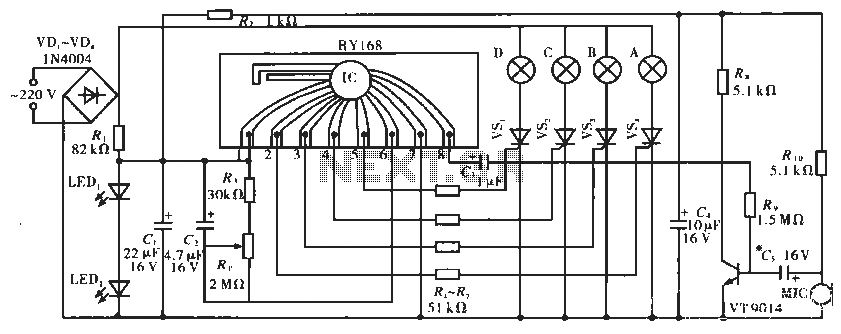
The circuit operates with a controller that includes a power supply circuit, a control circuit, and an audio amplifier, which are three distinct components. The power circuit comprises diodes VD1 to VD4, resistor R1, capacitor C1, LED1, LED2, and additional components. The circuit converts 220 V AC through VD1 and VD4, functioning as a full-wave bridge rectifier, to produce a pulsed red DC output suitable for powering four bulbs labeled A, B, C, and D. This pulsed DC is regulated using a Buck converter to limit the voltage, which in turn illuminates LED1 and LED2.
The circuit is designed to efficiently convert high-voltage AC into a usable DC format for various applications. The power supply section utilizes a full-wave bridge rectifier composed of diodes VD1 through VD4. This arrangement allows for the conversion of the alternating current (AC) input into direct current (DC) by allowing current to flow in a single direction, effectively smoothing the output waveform.
The output from the rectifier is a pulsed DC signal, characterized by its fluctuating voltage levels. To ensure that this output is suitable for driving the four bulbs (A, B, C, D), the circuit employs a Buck converter configuration. This step-down converter is essential for reducing the voltage level to a safe and functional range, which is particularly important for LED operation.
The inclusion of resistors and capacitors, such as R1 and C1, plays a critical role in filtering the rectified output and stabilizing the voltage. Capacitor C1 works to smooth out the ripples in the pulsed DC output, providing a more consistent voltage level to the load. The resistive element R1 may also be used to limit current and protect the circuit components from excessive current flow.
LED1 and LED2 serve as indicators within the circuit, providing visual feedback on the operational status. The illumination of these LEDs signifies that the circuit is functioning correctly and that power is being supplied to the connected bulbs. The overall design of this circuit ensures reliability and efficiency in converting and regulating electrical power for various lighting applications.Circuit works: The controller consists of a power supply circuit, a control circuit and audio amplifier is composed of three parts. Power circuit from the VD1 ~ VD4, R1,, C1, LED1 and LED2 and other components. After 220 V AC by VD1 VD4 a full-wave bridge rectifier output pulse red DC for four bulbs A, B, C, D use. This pulsed DC has been brother Buck limiting make LED1, LED2 light.
The circuit is designed to efficiently convert high-voltage AC into a usable DC format for various applications. The power supply section utilizes a full-wave bridge rectifier composed of diodes VD1 through VD4. This arrangement allows for the conversion of the alternating current (AC) input into direct current (DC) by allowing current to flow in a single direction, effectively smoothing the output waveform.
The output from the rectifier is a pulsed DC signal, characterized by its fluctuating voltage levels. To ensure that this output is suitable for driving the four bulbs (A, B, C, D), the circuit employs a Buck converter configuration. This step-down converter is essential for reducing the voltage level to a safe and functional range, which is particularly important for LED operation.
The inclusion of resistors and capacitors, such as R1 and C1, plays a critical role in filtering the rectified output and stabilizing the voltage. Capacitor C1 works to smooth out the ripples in the pulsed DC output, providing a more consistent voltage level to the load. The resistive element R1 may also be used to limit current and protect the circuit components from excessive current flow.
LED1 and LED2 serve as indicators within the circuit, providing visual feedback on the operational status. The illumination of these LEDs signifies that the circuit is functioning correctly and that power is being supplied to the connected bulbs. The overall design of this circuit ensures reliability and efficiency in converting and regulating electrical power for various lighting applications.Circuit works: The controller consists of a power supply circuit, a control circuit and audio amplifier is composed of three parts. Power circuit from the VD1 ~ VD4, R1,, C1, LED1 and LED2 and other components. After 220 V AC by VD1 VD4 a full-wave bridge rectifier output pulse red DC for four bulbs A, B, C, D use. This pulsed DC has been brother Buck limiting make LED1, LED2 light.
